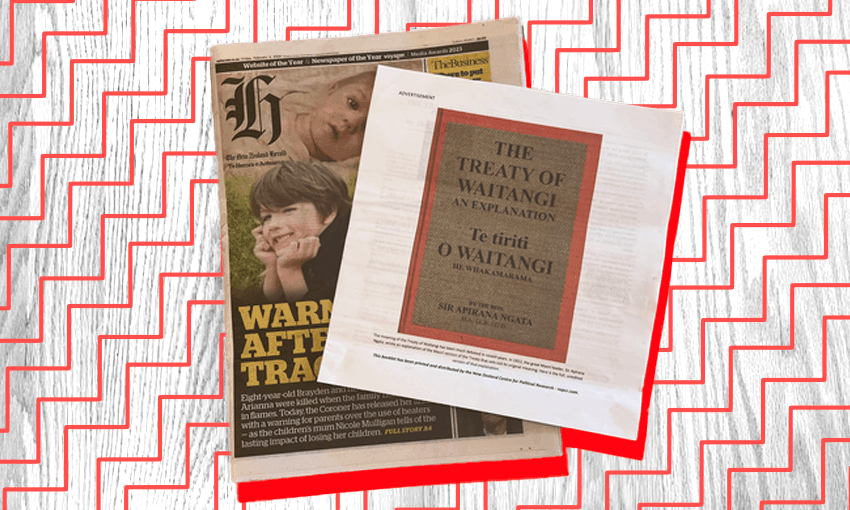The respected statesman’s 1922 explanation of the Treaty of Waitangi, which says Māori ceded sovereignty, featured in a newspaper advertorial last week. Law lecturer and Treaty scholar Carwyn Jones provides some much-needed context.
Last week, readers of the New Zealand Herald and The Post received an eight-page advertorial insert from rightwing thinktank the New Zealand Centre for Political Research (NZCPR*). This advertisement was a reproduction of the English translation of Apirana Ngata’s 1922 explanation of Te Tiriti o Waitangi. Putting to one side questions about who is funding the NZCPR to place these advertisements and what their aims are, there are a few things that might be useful to consider when thinking about how we should understand Ngata’s explanation.
What does Apirana Ngata say about Te Tiriti?
Ngata identifies that the central ideas in Te Tiriti relate to the nature of the authority to be exercised by the Crown and Māori respectively, and notes that without an understanding of the terms “kāwanatanga” and “mana rangatira”, “no one can consciously understand the full meaning of the Treaty of Waitangi”.
Ngata views the first article of the Treaty as a “complete cession” of governmental authority to the British Crown. “The main purport was the transferring of the authority of the Maori chiefs for making laws for their respective tribes and sub-tribes under the Treaty of Waitangi to the Queen of England for ever.”
Ngata quotes the famous words of the Te Rarawa rangatira Nopera Panakareao, who said “It is the shadow of the land which had been given to the Queen while the soil remains.”
Ngata comments:
“These are very wise words, an old time saying. The saying of the elderly chief has combined the words of the first article with those of the second article of the Treaty. It is the shadow, that is, the main authority covering the land; it is the power to make laws, the power to say this group shall adjudicate, that authority should see that the purchase is right, while that one leads the individual through the many intricacies of the law, that was the shadow ceded to the Queen by the first article of the Treaty. As for the soil, it is yours, it is mine inherited from our ancestors. It was the second article which firmly established this to the Maori people.”
That sounds pretty clear. So, Māori did cede sovereignty by signing Te Tiriti?
No. The Waitangi Tribunal has been clear that Māori did not give up their sovereignty by signing Te Tiriti. In its 2014 report, He Whakaputanga me Te Tiriti, the tribunal found that:
“The rangatira who signed te Tiriti o Waitangi in February 1840 did not cede their sovereignty to Britain. That is, they did not cede authority to make and enforce law over their people or their territories.”
That finding was based on a thorough review of all the historical evidence, the vast body of scholarship written about the nature of the agreement entered into, and submissions made by claimants and the Crown.
The tribunal summarised the agreement in Te Tiriti as follows:
- The rangatira agreed to share power and authority with Britain. They agreed to the governor having authority to control British subjects in New Zealand, and thereby keep the peace and protect Māori interests.
- The rangatira consented to the Treaty on the basis that they and the governor were to be equals, though they were to have different roles and different spheres of influence. The detail of how this relationship would work in practice, especially where the Māori and European populations intermingled, remained to be negotiated over time on a case-by-case basis.
- The rangatira agreed to enter land transactions with the Crown, and the Crown promised to investigate pre-Treaty land transactions and to return any land that had not been properly acquired from Māori.
- The rangatira appear to have agreed that the Crown would protect them from foreign threats and represent them in international affairs, where that was necessary.
So, is Ngata wrong to assert that the rangatira who signed Te Tiriti gave up their authority to govern themselves?
Yes. The legal, historical and constitutional research we have access to today all point to the fact that the rangatira did not give up the authority of their own communities. That authority is, in fact, guaranteed in Article 2. And this is not inconsistent with the grant of governmental authority to the Crown in Article 1.
But Ngata is an important and respected person, living at a time much closer to 1840 than we are. Shouldn’t we take his views seriously?
Yes, Ngata is an important figure and one of significant mana. We should not dismiss his views out of hand. But, respected figure though he is, he is only one person, and we should not uncritically accept his views without any other context.
Writing in 1922, Ngata is, of course, closer in time to when Te Tiriti was signed than we are in 2024. But his explanation is not an eyewitness account. Like us, he is providing an explanation based on the interpretation of historical events, the intentions of the parties as they can be discerned from the historical record, and the understanding of key concepts contained in the Treaty.
Ngata’s explanation appears to be grounded in the idea of sovereignty being an absolute and exclusive authority. To his mind, if governmental authority is granted to the Crown in Article 1, then there is no room for any form of continuing Māori authority. So, this must be a “complete cession” to the Crown.
But such an interpretation would be at odds with the explicit guarantee of Māori authority (tino rangatiratanga) in Article 2. And there is plenty of evidence that colonial officials in 1840, and in the years that followed, did not see continuing Māori authority as being necessarily inconsistent with an exercise of kāwanatanga or the governmental authority of the Crown. That is, the Crown’s authority here need not be understood as exclusive. It could in fact look just like the two spheres of influence and authority that the Waitangi Tribunal has described.
Isn’t it a good thing that groups like NZCPR are sharing information about Te Tiriti?
We should be encouraging people to share information about Te Tiriti. Apirana Ngata’s explanation can form a useful part of our discussion about Te Tiriti, its meaning, and how we ought to give effect to it today.
But we should not think of the perspective of any one person as being the definitive explanation. All views must be understood in context. We wouldn’t rely on one single explanation of the environmental impacts of the use of fossil fuels from 100 years ago to inform our response to climate change. And we shouldn’t rely on any one single view of Te Tiriti to inform our approach today. We should think about how one explanation sits among all the research that we have access to.
What else should I be reading then?
The Spinoff has already put together a great list of reading and other resources about Te Tiriti.
There is some highly accessible material there, and that list provides some really good places to start finding out more about Te Tiriti.
There are heaps of excellent resources out there about Te Tiriti, but if you are up for a deeper dive, two publications that are specifically relevant to giving context to Ngata’s explanation are:
- The Spinoff list already includes Ned Fletcher’s thorough consideration of the English text, The English Text of the Treaty of Waitangi. It’s a big book, but takes a detailed look at the various views informing the drafting and early application of the English text.
- And, I mentioned above, the Waitangi Tribunal’s 2014 report, He Whakaputanga me Te Tiriti. Again, there is lots of detail here, and this report is perhaps the most thorough investigation that the tribunal has produced about the meaning of Te Tiriti for those who signed in 1840.
*In the ad, two letters in NZCPR’s website are transposed, and the typo directs readers to nzpcr.com. Curiously, this URL now redirects to Re:News’ Understanding Te Tiriti video, which begins: “Māori didn’t intend to cede their sovereignty.”

